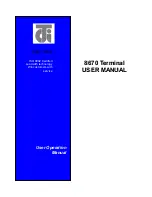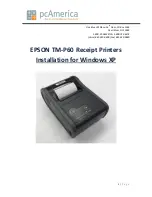
Introducing the 246X Stationary Terminal
1-3
1
This chapter introduces the TRAKKER
Antares
246X stationary terminals. You will
learn about the terminal connectors and learn how to understand the terminal's status
lights, status beeps, power, memory, and drives.
What Are the 246X Stationary Terminals?
The TRAKKER Antares 246X stationary terminals (2460 and 2461) are desktop data
collection terminals. You can use these programmable terminals to run client/server
applications such as work-in-process, time and attendance, or document tracking.
You use the 2460 and 2461 terminals to collect and upload data to a host computer via
serial or Ethernet communications. You can configure the terminal by scanning bar
codes or by downloading configuration commands from your host.
Note: The 246X terminals communicate with either the DCS 300 or the Model 200
Controller. The DCS 300 is a data collection server that replaces the Model 200
Controller.
2460
246XU.001
Models and Options for the 246X Terminals
The 246X terminals include these models:
2460
The 2460 is a programmable data collection terminal that uses serial ports to
transmit data to and receive data from a host or PC. The 2460 has two serial ports,
COM1 and COM2.
2461
The 2461 is a programmable data collection terminal that has both a serial port
and an Ethernet connector to transmit data and receive data. You can choose either
UDP Plus (DCS 300 network) or TCP/IP network protocol.
Summary of Contents for Trakker Antares 2460
Page 1: ...Trakker Antares 246X Stationary Terminal User s Manual...
Page 4: ...blank page...
Page 19: ...Introducing the 246X Stationary Terminal 1...
Page 20: ...blank page...
Page 29: ...Installing the Terminal 2...
Page 30: ...blank page...
Page 47: ...Configuring the Terminal 3...
Page 48: ...blank page...
Page 58: ...blank page...
Page 59: ...Operating the Terminal in a Network 4...
Page 60: ...blank page...
Page 88: ...blank page...
Page 89: ...Programming the Terminal 5...
Page 90: ...blank page...
Page 107: ...Troubleshooting 6...
Page 108: ...blank page...
Page 121: ...Reader Command Reference 7...
Page 122: ...blank page...
Page 149: ...Configuration Command Reference 8...
Page 150: ...blank page blank page...
Page 242: ...blank page blank page...
Page 243: ...Specifications A...
Page 244: ...blank page blank page...
Page 257: ...Full ASCII Charts B...
Page 258: ...blank page blank page...
Page 267: ...Using the Default Applications C...
Page 268: ...blank page blank page...
Page 279: ...Index I...
Page 280: ...blank page...
Page 290: ...body text 4...
















































